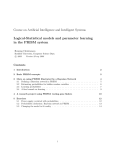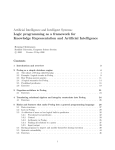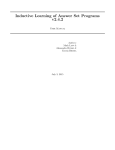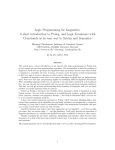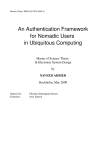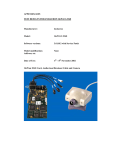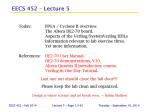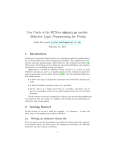Download HC3
Transcript
Abductive reasoning in Prolog and CHR
A short introduction for the KIIS course, autumn 2005
Henning Christiansen
Roskilde University, Computer Science Dept.
Denmark
c 2005 by the author. Version 27 sep 2005
1
Deduction, abduction, and induction in logic
programming
The philosopher C.S.Peirce (1839–1914) is considered a pioneer in the understanding of human reasoning, especially in the specific context of scientific discovery. His work is often cited in computer science literature but
probably only few computer scientists have read Peirce’s original work. We
recommend [7] as overview of Peirce’s influence seen from the perspective of
computer science.
Peirce postulated three principles as the fundamental ones:
• Deduction, reasoning within the knowledge we have already, i.e.,
from those facts we know and those rules and regularities of the world
that we are familiar with. E.g., reasoning from causes to effects:
“If you make a fire here, you will to burn down the house.”
• Induction, finding general rules from the regularities that we have
experienced in the facts that we know; these rules can be used later
for prediction:
“Every time I made a fire in my living room, the house burnt down,
aha, ... the next time I make a fire in my living room, the house will
burn down too”.
• Abduction, reasoning from observed results to the basic facts from
which they follow, quite often it means from an observed effect to
produce a qualified guess for a possible cause:
“The house burnt down, perhaps my cousin has made a fire in the
living room again.”
In fact, Peirce had alternative theories and definitions of abduction and
induction; we have adopted the so-called syllogistic version, cf. [7]. We can
replicate the three in logic programming terms:
1
• A Prolog system is a purely deductive engine. It takes a program of
rules and facts, and it can calculate or check the logical consequences
of that program.
• Induction is difficult; methods for so-called inductive logic programming (ILP) have been developed, and by means of a lot of statistics
and other complicated machinery, it synthesizes rules from collections
of “facts” and “observations”. We refer to [2]1 for an overview of
different applications. Inductive logic programming has been successfully applied for molecular biology concerned with protein molecule
shapes and human genealogy. See [10] for an in-depth treatment of
ILP methods.
• Abductive logic programming; roughly means from a claim of goal
that is required to be true (i.e., being a consequence of the program),
to extend to program with facts so that the goal becomes true. See [9]
for an overview. Abduction has many applications; we may mention
planning (e.g., goal is “successful project ended” and the facts to be
derived are the detailed steps of a plan to achieve that goal), diagnosis
(goal is observed symptoms, the facts to be derived comprise the diagnosis, i.e., which specific components of the organism or technical system that malfunction). An important area for abduction is language
processing, especially discourse analysis (the discourse represents the
observations, the facts to be derived constitute an interpretation of
that discourse). We will look into some of these in more detail below
and give references.
However, we should be aware that while deduction is a logically sound way
of reasoning, this is generally not the case for abduction and induction. We
will make a simple analysis for abduction. Assume a logical knowledge base
{a → c, b → c} where the arrow means logical implication. If we know c,
an abductive argument may propose that a is the case, however, this is not
necessarily true as it might that b is the case and not a, or it could even be
the case that none of a and b are the case, and that there is another and
unknown explanation for c. Abduction is often described as reasoning to the
best explanation. i.e., best with respect to the knowledge we have available.
2
A definition of abductive logic programming
(This section is adapted from [3]). An abductive logic program [9] is usually
specified as a triplet hP, A, ICi where P is a logic program, A a set of abducible predicates that do not occur in the head of any clause of P, and IC
1
A bit old; if you are interested, you should search for more recent overview papers
and consult proceedings of the recent ILP conferences; see http://www.informatik.unitrier.de/~ley/db/conf/ilp/index.html.
2
a set of integrity constraints assumed to be consistent. Assume additionally
that P and IC can refer to a set of built-in predicates that have a fixed
meaning identified as a theory B; a predicate in P that is neither abducible
nor built-in is called defined. A typical built-in predicate is the dif/2 predicate of SICStus Prolog [11]; dif(X,Y) means that X and Y must be different.
We assume for simplicity in the following that IC refers to abducible and
built-in predicates only.
Given an abductive logic program hP, A, ICi, we define for pairs of sets
of abducibles and built-in atoms hA, Bi, a consistent ground instance to be
a common ground instance2 hA0 , B 0 i of hA, Bi so that3
• B |= B 0 (the instance of built-ins is satisfied)
• B ∪ A0 |= IC (the instance of abducibles respects the integrity constraints)
For simplicity and without loss of generality, we consider only ground queries;4
an abductive answer to a query Q is a pair of finite sets of abducible and of
built-in atoms hA, Bi such that
• hA, Bi has at least one consistent ground instance hA0 , B 0 i,
• for any such hA0 , B 0 i, we have P ∪ A0 |= Q.
In other words, the abductive answer should be consistent and, if the abducible atoms were added to the programs as if they were ordinary Prolog
facts, the query would succeed.
Minimality and Compaction
It is often required that an abductive answer be minimal measured in the
number of abduced literals (or, alternatively, in a subset relation or subsumption ordering). If, for example, the query “?- happy(me).” has the
set
A1 = {rich(me), has(me,nice students), moon(full)}
is an abductive answer, and that
A2 = {rich(me), has(me,nice students)}
also is an abductive answer, then somehow, the fact moon(full) does not
seem very interesting, as the smaller answer A2 can explain the query. The
2
We recall that an expression is ground if it contains no variable. A common ground
instance means that the same grounding substitution is applied to both A and B.
3
Recall that |= can be read as “entails” or “ has the logical consequence”.
4
For example, “?- happy(me).” is a ground query but “?- happy(X).” is not. Considering only ground queries means that we can ignore the traditional answer substitution;
this can easily be added.
3
answer A2 is minimal provided that none of its subsets are abductive answers, i.e., neither {rich(me)} nor {has(me,nice students)} can explain
the query.
Most published abduction algorithms try to unify a new abducible with
one already produced (as to produce answers of a minimum number of literals), and tries out different alternatives under backtracking. This does not
guarantee minimality in cases when, say, one branch of executions produces
abducibles a and b but another may produce only a. Minimal answers can
be selected by post-processing all answers found in this way. However, we
argue that this principle which we call compaction is not always obvious or
desirable, and we suggest it be optionally specified for selected abducible
predicates.
If, for example, someone’s car was stolen in Paris and his wallet in New
York, it seems over-constrained to assume by default that the thieves are
the same one. In other words, if both
B1 = {steel(X,wallet), steel(Y,car), thief(X), thief(Y)}
and
B2 = {steel(X,wallet), steel(X,car), thief(X)}
are abductive answers to a given query, we claim that it is not obvious that
B2 should be considered the best. In fact, when you write B2 as B1 ∪ {X=Y}
seems that B1 is smallest in some sense.
3
Abduction implemented in Prolog with a little
help from CHR
(This section adapted from [6, 3]; see those papers for references to earlier
work).
Constraint Handling Rules [8], CHR, is a declarative, rule-based language for writing constraint solvers and is now included as an extension of
several versions of Prolog. Operationally and implementation-wise, CHR extends Prolog with a constraint store, and the rules of a CHR program serve
as rewriting rules over constraint stores. CHR is declarative in the sense
that its rules can be understood as logical formulas. Constraint predicates
must be declared as such and can then be called from a Prolog program;
see [8] for details. The following example declares a constraint predicate a
and defines a so-called propagation rule.
constraints a/1.
a(1), a(2) ==> fail.
This rule identifies a state as illegal if it contains the two indicated constraints. As first noticed by [1], there is a clear analogy between abducibles
plus integrity constraints and CHR’s constraints plus rules.
4
The implementation of abduction in Prolog with CHR is simple. Abducibles are viewed as constraints in the sense of CHR: the logic program
is executed by the Prolog system; whenever an abducible is called it is
added automatically by CHR to the constraint store and CHR will activate
integrity constraints whenever relevant. The complete hand-coded implementation of an abducible predicate a/1 is provided by the following three
lines.
:- use_module(library(chr)).
handler abduction.
constraints a/1.
Compaction for a/1 is implemented by a single CHR rule; the following
provides a correct implementation.
a(X), a(Y) ==> true | (X=Y ; dif(X,Y)).
The implementation used in the HYPROLOG system [3] applies a slightly
optimized version of this rule using low-level facilities of CHR.
In addition, the integrity constraints mentioned above can be written
directly as CHR rules.
In a comparison with other abductive logic programming systems we
may emphasize the following; see [3] for more detailed comments.
• The indicated method is limited with respect to negation. There are
important applications (see, e.g., [9]) that requires the creation of new
abducibles from within negated calls to predicates. Our method can
handle a limited form of so-called explicit negation which is hardwired into the HYPROLOG system [3], but which cannot handle the
indicated applications.
• However, for the applications that this methodology can handle, it is
considerably faster that other, known systems for abduction. The reason for this is that we utilize the underlying technology in an optimal
and direct way, as no intermediate level of interpretation is involved.
• Important applications such as many cases of diagnosis and natural
language analysis can be modeled nicely without negation.
4
A first example of abduction in Prolog+CHR
This is extends a standard example from the literature, used by [9] and
others. Consider the following Prolog program:
grass_is_wet:- rained_last_night.
grass_is_wet:- sprinkler_was_on.
5
It has two rules and no facts. Obviously the following query fails when
executed in Prolog:
?- grass_is_wet.
no
On the other hand, an abductive system should not give up that easily. It
should do what it can to enforce that the query succeeds, and the only way
it can do so is by suggesting which facts to add to the program.
A typical abductive interpreter do not actually modify the program
source text but produces an abductive answer (as defined above) consisting of those facts, that if they were added to the program would make the
query succeed. With an abductive interpreter, and provided that predicates
rained last night and sprinkler was on are declared as abducibles, we
may experience a dialogue as follows:
?- grass_is_wet.
rained_last_night ? ;
sprinkler_was_on ? ;
no
We can illustrate the meaning of these two answers by stating that the query
?- grass is wet. would succeed when executed by a Prolog system given
one of the following two Prolog programs (no CHR or abduction involved
this time).
grass_is_wet:- rained_last_night.
grass_is_wet:- sprinkler_was_on.
rained_last_night.
grass_is_wet:- rained_last_night.
grass_is_wet:- sprinkler_was_on.
sprinkler_was_on.
Basically, an abductive interpreter works in the way that when it enters
an abducible goal that otherwise would fail in Prolog, it simply notes that
goal as part of the abductive answer. As we indicated above, CHR’s constraint store can serve as a container for the abductive answer being built
up gradually as the execution goes on.
Consider the following program that combines Prolog and CHR as we
indicated above; two predicates are declared as constraints so that they will
be treated as abducibles:
handler garden_humidity1.
constraints rained_last_night/0, sprinkler_was_on/0.
grass_is_wet:- rained_last_night.
grass_is_wet:- sprinkler_was_on.
When this program is executed, the constraints entered are added to the
constraint store. The declaration handler garden humidity. is not important, but CHR’s syntax requires such a declaration.
6
The resulting constraint store is printed as part of the answer and we
get exactly the following when asking a query for grass is wet.
?- grass_is_wet.
rained_last_night ? ;
sprinkler_was_on ? ;
no
Integrity constraints can be seen as a way to rule out “weird” abductive
answers, and these integrity constraints can be understood intuitively and in
their precise semantics as integrity constraints for databases. Let us extend
the program above with one more abducible predicate and a straightforward
CHR rule that serves as an integrity constraint.
handler garden_humidity2.
constraints rained_last_night/0, sprinkler_was_on/0,
full_moon_last_night/0.
rained_last_night, full_moon_last_night ==> fail.
grass_is_wet:- rained_last_night.
grass_is_wet:- sprinkler_was_on.
The integrity constraint reads: If the constraint store contains the two constraints indicated by its lefthand side, then its body (following the arrow) is
executed and here producing a failure. The following query to the program
shows that only one answer is produced, as the potential second one triggers
the integrity constraint.
?- full_moon_last_night, grass_is_wet.
full_moon_last_night,
sprinkler_was_on ? ;
no
Integrity constraints can contain any executable expression a its body, in
particular another abducible. Consider the following.
handler garden_humidity3.
constraints rained_last_night/0, sprinkler_was_on/0,
full_moon_last_night/0, mixed_weather_last_night/0.
rained_last_night, full_moon_last_night ==> mixed_weather_last_night.
grass_is_wet:- rained_last_night.
grass_is_wet:- sprinkler_was_on.
7
This results in the following:
?- full_moon_last_night, grass_is_wet.
rained_last_night, mixed_weather_last_night ? ;
sprinkler_was_on ? ;
no
Notice that the additional abducible mixed weather last night is only produced by for the first answer, as the integrity constraint is not triggered for
the second one.
5
Database view update considered as abduction
The following program written in Prolog plus CHR defines a little database
with integrity constraints, that express so-called key constraints on the
father and mother relations, i.e., “you can only have one father and only
one mother”. The grandfather predicate corresponds to a view definition
in a traditional database.
:- use_module(library(chr)).
handler view_update.
constraints father/2, mother/2.
father(X,Y), father(Z,Y) ==> Z=X.
mother(X,Y), mother(Z,Y) ==> Z=X.
grandfather(X,Z):- father(X,Y), father(Y,Z).
grandfather(X,Z):- father(X,Y), mother(Y,Z).
current_db:father(peter, paul),
father(paul,jens),
mother(marie,jens).
It may seem a bit confusing that the current database is not defined by
means of facts as usual, but this strange way above is needed in order to
provide an interaction between new and old database facts.
In order to perform a view update to a given database, we can give it
as a query, here using the auxiliary predicate current db. The query below
reads informally “In which ways can some X be a grandfather of jens. Notice
that we get the the whole updated database as answer.
?- current_db, grandfather(X,jens).
X = peter,
8
father(peter,paul),
father(paul,jens),
mother(marie,jens),
father(peter,paul),
father(paul,jens) ? ;
father(peter,paul),
father(paul,jens),
mother(marie,jens),
father(X,marie),
mother(marie,jens) ? ;
no
The first answer suggests that peter could be grandfather of jens, provided
the new fact father(paul,jens) is added to the database. The second
answer does not indicate a specific value for X but indicates that any value v
for X will do provided that father(v,marie) is added to the database. (For
technical reasons that we shall not comment on here, some database facts
becomes duplicated; this is easy to avoid by simple techniques in CHR.)
6
Simple diagnosis problems formulated as abduction
In a case of medical diagnosis, the patient is explaining various symptoms,
“I have pain here, and here, but not here ....”, and the doctor’s job is
to give the diagnosis which may the identification of a particular decease
that can explain the observed symptoms. We can consider this as a case
of abduction. The doctor’s knowledge includes a large collection of rules
about which deceases and conditions that may cause which symptoms. In
the particular case, he should be able to figure out what are the specific
deceases and conditions that can explain this patient’s symptoms. Maybe a
combination of deceases must be suggested in order to explain symptoms.
It is interesting to notice that the doctor uses his knowledge in order
to provide statements about the patient’s internal state without actually
opening the patient. In other words, he is making predictions about hidden
information that cannot be immediately checked in reality, and what is
available to make the judgment are externally observed symptoms. This
little discussion also indicates the potential unsound nature of abduction,
in that the doctor may have chosen the wrong out of alternative diagnoses.
This may then be corrected by new observations, say, that the suggested
medical treatment has no effect, by further questioning of the patient, or
from surgical investigations.
We use the notion of diagnosis in a more wide sense for finding explanations for systems that shows certain wrong behaviour. By system, we mean
9
here a structure of interconnected primitive components, and where possible malfunctioning is caused by the malfunctioning of one or more of the
primitive components. We will formulate this task as an abductive problem
and show how it can be solved with abductive logic programming.
Example: Logical circuits
(Copied with a few changes from [5] in order to make this document selfcontained). We indicate here how logical circuits can be simulated by Prolog
programs, and later we extend the example with abduction for diagnosis.
Logical circuits represent a graphical formalism that serves as an abstract
model of a class of electronic circuits composed by conductors and gates that
can be thought of as performing logical operations. A physical component
corresponding to the “not” gate below behaves in the following way: If a
potential of about five volts is imposed on the input connector to the left
in the diagram below, a potential of about zero volts can be observed at
the output connector to the right (and the other way round for an input of
about zero volts). The actual technology may be based on another pair of
voltages than roughly-five/roughly-zero; the only interesting property is that
the gates behave in a consistent way with respect to the logical behaviour.
See, e.g., [12], chap. 3, for background and more information.
We represent the value corresponding to logical “truth” by the constant
symbol 1 and logical “falsity” by 0. The fact that these symbols in some
context may serve as numbers in Prolog is of no interest here; we could in
principle have used any other pair of two distinct constant symbols.
A given gate (or circuit) can be defined as a predicate whose arguments
represent the gate’s (or circuit’s) input and output connectors. A “not”
gate, for example, can be specified by the following table.
not
A
X
A
0
1
X
1
0
The corresponding definition in Prolog is the following sequence of facts,
one for each row in the table.
not(0, 1).
not(1, 0).
“And” and “exclusive-or” gates are specified in similar ways, and so on for
gates corresponding to other logical functions.
10
A
and
A
X
X
B
B
A
0
0
1
1
xor
B
0
1
0
1
X
0
0
0
1
A
0
0
1
1
B
0
1
0
1
X
0
1
1
0
The corresponding predicates and(A, B, X) and xor(A, B, X) are defined
as follows.
and(0,
and(0,
and(1,
and(1,
0,
1,
0,
1,
0).
0).
0).
1).
xor(0,
xor(0,
xor(1,
xor(1,
0,
1,
0,
1,
0).
1).
1).
0).
In the graphical language, gates are put together by connecting the components by means of conductors. In Prolog, we can do very much the same
thing, except that we use variables instead of conductors. The following
picture shows a so-called half-adder circuit.
A
Sum
B
Carry
It can be described by a predicate defined as follows.
halfadder(A, B, Carry, Sum):and(A, B, Carry),
xor(A, B, Sum).
The following more complicated circuit is known as a full adder.
Carry in
A
Sum
B
Carry out
11
It involves some internal conductors that are not connected to the circuit’s
external connectors. In the Prolog version, these conductors are replaced
by variables that recur in the subgoals of the body but do not occur in the
head, here X, Y, and Z.
fulladder(Carryin, A, B, Carryout, Sum):xor(A, B, X),
and(A, B, Y),
and(X, Carryin, Z),
xor(Carryin, X, Sum),
or(Y, Z, Carryout).
The program explained in this section is a model of a physical system and
we can use the program to predict properties of this system. We may,
for example, pose a query that for a given set of input values (abstract
potentials) calculates the output values.
?- fulladder(1, 0, 1, C, S).
C = 1
S = 0 ? ;
no
This shows that the circuit for adding a 0 and a 1 given a previous carry
of 1 produces sum 0 with new carry 1, and it appears that this is the only
solution.
6.1
Diagnosis based on the assumption of periodic faults
“Periodic fault” is a technical term which is a bit misleading, as it refers a
fault that occurs now and then with irregular and unpredictable intervals.
Thus such periodic faults are very difficult to find, and as we will see, also
computationally very complex.
We describe the principles for the example of logical circuits introduced
above. First of all, we need to assign an identifier to each occurrence of a
gate in the circuit in order to point out (in the abductive answers), which
components are defect. We may extend the clauses that define given circuit
in the following way.
halfadder(A, B, Carry, Sum):and(A, B, Carry, and0),
xor(A, B, Sum, xor0).
fulladder(Carryin, A, B, Carryout, Sum):xor(A, B, X, xor1),
and(A, B, Y, and1),
and(X, Carryin, Z, and2),
12
xor(Carryin, X, Sum, xor2),
or(Y, Z, Carryout, or1).
Notice that we have used predicates for the individual gates which take the
extra argument for the identifier. We should then define these predicates
so that they take into account the possible malfunctioning of the gate. We
give the definition for “and” and explain it in the following.
and(A,B,X,ComponentId):and(A,B,X),
perfect(ComponentId).
and(A,B,X,ComponentId):and(A,B,Z), disturbe(Z,X),
defect(ComponentId).
disturbe(0,1).
disturbe(1,0).
The disturbe predicate is applied for the other types of gates as well in
a similar way. The point of using disturbe is that we only notice that
something is wrong with a given component if it produces the wrong result
for given input; and/3 refers to the previous definition of logical-and.
Before discussing the details of predicates perfect and defect, let us
consider how observations are given. Observations represent observed tests
assumed to be made using some actual device, whose structure is modeled
by the logic programs shown. More precisely, observations and recorded
samples of input-output pairs. For example, if a given half-adder device
when given input A=1, B=1 produces Carry=1 and Sum=1, this indicates a
wrong result and that something must be wrong inside the circuit.
The purpose of the extended predicates is, then, that we can present
them with queries of observed input-and-output in the following ways, for
having them analyzed. For example:
?- halfadder(1,1,1,1).
The output should, then be abducible answers consisting of perfect and
defect facts. Referring to the method for implementing abduction in Prolog
plus CHR above, we can make the two to work as abducible predicates by
the following declarations.5
:- use_module(library(chr)).
handler diagnosis.
constraints perfect/1, defect/1.
5
Notice that we could have implemented this example with only the defect predicate,
with the default assumption being perfect behaviour. However, having the two is practical
for the modification of the method that we will do in the following subsection.
13
We define the following integrity constraints that govern the interaction
among the perfect and defect constraints.
defect(X) \ defect(X) <=> true.
perfect(X) \ perfect(X) <=> true.
defect(X) \ perfect(X) <=> true.
The first two rules simply remove duplicates, but the third one is interesting.
It is a simpagation rule that reads intuitively: if a gate once have shown
to be defect, it will be remembered even though the gate in some cases has
produced the correct result. In other words, a given gate must expose wrong
behaviour at least once in order to be registered as defect. This materializes
the periodic fault assumption. Let us test a few queries.
?- halfadder(1,1,1,1).
perfect(and0),
defect(xor0) ? ;
no
This shows that exclusive-or gate that determines the Sum output argument
needs to be defect in order to produce this behaviour, and also that there is
no reason, from the given observation, to assume the and-gate to be defect.
The problem hight complexity given by the periodic fault assumption
is apparent when we give more observations to a more complex circuit.
Consider the following query that represents three wrong results.
?- fulladder(1,0,1,1,1), fulladder(1,1,1,0,0), fulladder(0,0,0,0,1).
It produces the total of 512 possible solutions, including duplicate solutions
produced in different ways. This high number arises from a number of
reasons.
• The method proposes a lot of explanations that include defects that
compensate for each other.
• Combining this with the periodic fault assumption which says that a
defect gate may sometimes do the right and sometimes the wrong, the
set of possibilities explodes.
• Finally, the method is not able to use observations about correct behaviour in any way.6
The last point is critical. This corresponds to a doctor who is not able to
take into account the observation that “... otherwise the patient is strong
and healthy.”
6
In fact, even for queries representing entirely correct behaviour, the method proposes
a lot of possible defects that mutually compensate for each other.
14
6.2
Diagnosis based on the assumption of consistent faults
Consistent faults means that a given primitive component always exposes
the same output for the same input. In the example of logical circuits,
it may be that case that a particular occurrence of a gate produces a 0
when anding two 1es. This means that it is not sufficient to record just
that the gate is defect, but we must record for which inputs it gives right
results and for which inputs it gives wrong results. For this purpose, we
extend the abducible predicates with additional arguments so that, say,
defect(and3,1,1) means that the indicated gate and3 gives wrong results
when given the input of two 1es. We can implement this in the following
way, with integrity constraints that materialize the assumption of consistent
faults.
:- use_module(library(chr)).
handler diagnosis.
constraints perfect/3, defect/3.
defect(X,In1,In2) \ defect(X,In1,In2) <=> true.
perfect(X,In1,In2) \ perfect(X,In1,In2) <=> true.
defect(X,In1,In2) , perfect(X,In1,In2) <=> fail.
As in the previous version, the first two rules remove duplicates, and the last
one is important. It indicates that it is not possible to create an abductive
explanation that claims two different behaviours for the same component
and given input.
The predicate definitions for the entire circuits remain the same, and
those for the individual gates are adapted as follows.
and(A,B,X,ComponentId):and(A,B,X),
perfect(ComponentId,A,B).
and(A,B,X,ComponentId):and(A,B,Z), disturbe(Z,X),
defect(ComponentId,A,B).
The following is an example of a query that consists of one wrong and one
correct observation.
?- halfadder(1,1,0,1), halfadder(1,0,0,1).
defect(and0,1,1),
defect(xor0,1,1),
perfect(and0,1,0),
perfect(xor0,1,0) ? ;
no
15
Only one answer is given. It is interesting to see that the answer also gives
information about how throughly the circuit has been tested. It can be seen
that the and0 gate’s behaviour on input 0-0 has not been tested, so if the
purpose is a thorough test of the circuit, it might be a good idea to try more
samples so that defect(and0,0,0) or perfect(and0,0,0) may show up.
Another interesting query is this one.
?- halfadder(1,1,1,0), halfadder(1,1,1,1), halfadder(0,0,1,0).
no
How can we interpret this results? Well, it indicates that there is no diagnosis for these observations under the consistent fault assumption. Two
things can be wrong, then. Either the actual device does not obey the consistent fault assumptions (in which case we must go back to periodic fault
assumption), or that the observations are wrong so that we should redo the
tests using the device once again.
To see the difference between periodic and consistent, we recall that the
following query produced 512 solution with perodic, and under consistent
fault assumption, it produces “only” 144 solutions.
?- fulladder(1,0,1,1,1), fulladder(1,1,1,0,0), fulladder(0,0,0,0,1).
This is still quite many solutions, but we may improve by adding samples
of correct input-out behaviour for our circuit (which, of course, only can
be defended if we have performed test using the given device, that actually
produced these results).
?- fulladder(1,1,0,1,0), fulladder(0,1,0,0,1), fulladder(0,0,1,0,1),
fulladder(1,0,1,1,1), fulladder(1,1,1,0,0), fulladder(0,0,0,0,1).
This limits to now 48 solutions, and a careful study of those indicates that
many of them describe combinations of mutually compensating errors which
makes the circuit produce the correct samples in wrong ways, so to speak.
To compensate for this, we introduce a principle that we may call the
correct-results-produced-in-correct-way assumption, which may not
always be realistic but may help to bring down complexity. By this principle, we indicate that those inputs that are run through the different gates
for the correct observation are assumed always to be correct, i.e., for such
combinations we should freeze suitable perfect abducibles. This is very
easy to implement in the model presented so far. First of all, notice that
the clauses for the and/4 predicate are ordered so that the solution consisting of perfect abducibles is tried before any other which includes defect
abducibles. In other words, the first solution found for observations of correct behaviour will consists of perfect abducibles only. (Any other possible
solutions with mutually compensating errors are produced afterwards on
backtracking.)
16
Here Prolog’s cut can be used effectively as indicated in the following
schema for giving the queries.
?- hcorrect-samplesi, !, hincorrect-samplesi.
This means that backtracking can only occur inside the analysis of the incorrect samples, and the abducibles from the correct ones stay fixed as perfect.
We may apply this principle to the qeury above.
?- fulladder(1,1,0,1,0), fulladder(0,1,0,0,1), fulladder(0,0,1,0,1),
!,
fulladder(1,0,1,1,1), fulladder(1,1,1,0,0), fulladder(0,0,0,0,1).
In fact this gives a disappointing no which may be a consequence of the
correct-results-produced-in-correct-way assumption not being applicable here.
Or rather, it indicates that these data have been produced artificially. A
more convincing example is the following which without the cut produced
72 solutions, but with the cut only the one solution indicated.
?- fulladder(0,1,1,1,0), fulladder(0,1,0,0,1), fulladder(0,0,1,0,1),
!,
fulladder(1,0,1,1,1), fulladder(1,1,1,0,0), fulladder(0,0,0,0,1).
defect(xor2,1,1),
defect(and2,0,1),
defect(xor2,1,0),
defect(or1,1,1),
defect(xor1,0,0) ? ;
no
7
Discourse analysis as abduction
This section is not expanded in the present version; we refer to the articles [4, 3] for more information; perhaps you may need also to consult an
introduction to Definite Clause Grammars which can be found in most textbooks on Prolog.
References
[1] Slim Abdennadher and Henning Christiansen. An experimental CLP
platform for integrity constraints and abduction. In Proceedings of
FQAS2000, Flexible Query Answering Systems: Advances in Soft Computing series, pages 141–152. Physica-Verlag (Springer), 2000.
[2] Ivan Bratko and Stephen Muggleton. Applications of inductive logic
programming. Commun. ACM, 38(11):65–70, 1995.
17
[3] H. Christiansen and V. Dahl. HYPROLOG: a new approach to logic
programming with assumptions and abduction. In Maurizio Gabbrielli
and Gopal Gupta, editors, Proceedings of Twenty First International
Conference on Logic Programming (ICLP 2005), Lecture Notes in Computer Science, 2005. To appear.
[4] H. Christiansen and V. Dahl. Meaning in Context. In Anind Dey,
Boicho Kokinov, David Leake, and Roy Turner, editors, Proceedings of
Fifth International and Interdisciplinary Conference on Modeling and
Using Context (CONTEXT-05), volume 3554 of Lecture Notes in Artificial Intelligence, pages 97–111, 2005.
[5] Henning
Christiansen.
Introduction
to
Prolog
as
a
database
language.
A
course
note,
2003.
http://www.ruc.dk/~henning/KIIS05/DatabaseProlog.pdf
[6] Henning Christiansen and Veronica Dahl. Assumptions and abduction
in Prolog. In Elvira Albert, Michael Hanus, Petra Hofstedt, and Peter
Van Roy, editors, 3rd International Workshop on Multiparadigm Constraint Programming Languages, MultiCPL’04; At the 20th International Conference on Logic Programming, ICLP’04 Saint-Malo, France,
6-10 September, 2004, pages 87–101, 2004.
[7] Peter A. Flach and Antonis C. Kakas, editors. Abduction and Induction:
Essays on their relation and integration. Kluwer Academic Publishers,
April 2000.
[8] Thom Frühwirth. Theory and practice of constraint handling rules,
special issue on constraint logic programming. Journal of Logic Programming, 37(1–3):95–138, October 1998.
[9] A.C. Kakas, R.A. Kowalski, and F. Toni. The role of abduction in
logic programming. Handbook of Logic in Artificial Intelligence and
Logic Programming, vol. 5, Gabbay, D.M, Hogger, C.J., Robinson, J.A.,
(eds.), Oxford University Press, pages 235–324, 1998.
[10] Shan-Hwei Nienhuys-Cheng and Ronald de Wolf, editors. Foundations
of Inductive Logic Programming, volume 1228 of Lecture Notes in Computer Science. Springer, 1997.
[11] Swedish Institute of Computer Science.
SICStus Prolog
user’s manual, Version 3.12.
Most recent version available at
http://www.sics.se/isl, 2004.
[12] Andrew S. Tanenbaum. Structured Computer Organization. AddisonWesley, 4th edition, 1999.
18




















